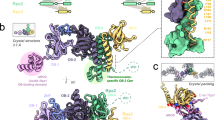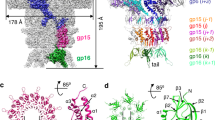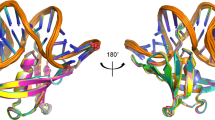Abstract
The topological state of DNA is of importance in a variety of essential biological events1–4. Covalently closed circular DNA duplexes isolated from eukaryotic cells and their viruses, as well as from eubacteria and their bacteriophages are, without exception, negatively supercoiled. Little is known about the topological state of the DNA in archaebacteria, a group of organisms distinct from both ekaryotes and eubacteria5, but recently an ATP-dependent DNA topoisomerase has been isolated from the archaebacterium Sulfolobus acidocaldarius. This enzyme, termed ‘reverse gyrase’, converts relaxed or negatively supercoiled DNA into positively supercoiled forms in vitro6–9. It is not a gyrase-like type II topoisomerase, as initially reported9, but an ATP-dependent type I enzyme7,8. The function of this enzyme in vivo has not been established, largely because of the lack of data on the topological state of Sulfolobus DNA. Here we show that DNA exists in a positively superhelical state in the genome of the virus-like particle SSV-1, present in Sulfolobus.
This is a preview of subscription content, access via your institution
Access options
Subscribe to this journal
Receive 51 print issues and online access
$199.00 per year
only $3.90 per issue
Buy this article
- Purchase on Springer Link
- Instant access to full article PDF
Prices may be subject to local taxes which are calculated during checkout
Similar content being viewed by others
References
Wang, J. C. Ann. Rev. Biochem. 54, 665–697 (1985).
Drlica, K. Microbiol. Rev. 48, 273–289 (1984).
Glikin, G. C., Ruberti, I. & Worcel, A. Cell 37, 33–41 (1984).
Pruss, G. J., Manes, S. H. & Drlica, K. Cell 31, 35–42 (1982).
Woese, C. R. & Fox, G. E. Proc. natn. Acad. Sci. U.S.A. 74, 5088–5090 (1977).
Mirambeau, G., Duguet, M. & Forterre, P. J. molec. Biol. 179, 559–563 (1984).
Forterre, P., Mirambeau, G., Jaxel, C., Nadal, M. & Duguet, M. EMBO J. 4, 2123–2128 (1985).
Nakasu, S. & Kikuchi, A. EMBO J. 4, 2705–2710 (1985).
Kikuchi, A. & Asai, K. Nature 309, 677–681 (1984).
Martin, A. et al. EMBO J. 3, 2165–2168 (1984).
Zillig, W. et al. System. appl. Microbiol. 7 (in the press).
Yeats, S., McWilliam, P. & Zillig, W. EMBO J. 1, 1035–1038 (1982).
Peck, L. J. & Wang, J. C. Proc. natn. Acad. Sci. U.S.A. 80, 6206–6210 (1983).
Pruss, G. J. J. molec. Biol. 185, 51–63 (1985).
Lazo, P. Biochem. J. 231, 185–188 (1985).
Maniatis, T., Fritsch, E. F. & Sambrook, J. in Molecular Cloning, 90–91 (Cold Spring Harbor Laboratory, New York, (1982).
Duguet, M., Lavenot, C., Harper, F., Mirambeau, G. & De Recondo, A. M. Nucleic Acids Res. 11, 1050–1075 (1983).
Champoux, J. J. & MacConaughy, B. L. Biochemistry 15, 4638–4642 (1976).
Author information
Authors and Affiliations
Rights and permissions
About this article
Cite this article
Nadal, M., Mirambeau, G., Forterre, P. et al. Positively supercoiled DNA in a virus-like particle of an archaebacterium. Nature 321, 256–258 (1986). https://doi.org/10.1038/321256a0
Received:
Accepted:
Issue Date:
DOI: https://doi.org/10.1038/321256a0
This article is cited by
-
Increase of positive supercoiling in a hyperthermophilic archaeon after UV irradiation
Extremophiles (2019)
-
Insight into the cellular involvement of the two reverse gyrases from the hyperthermophilic archaeon Sulfolobus solfataricus
BMC Molecular Biology (2014)
-
Molecular biology of fuselloviruses and their satellites
Extremophiles (2014)
-
The legacy of Carl Woese and Wolfram Zillig: from phylogeny to landmark discoveries
Nature Reviews Microbiology (2013)
-
Hot crenarchaeal viruses reveal deep evolutionary connections
Nature Reviews Microbiology (2006)
Comments
By submitting a comment you agree to abide by our Terms and Community Guidelines. If you find something abusive or that does not comply with our terms or guidelines please flag it as inappropriate.



